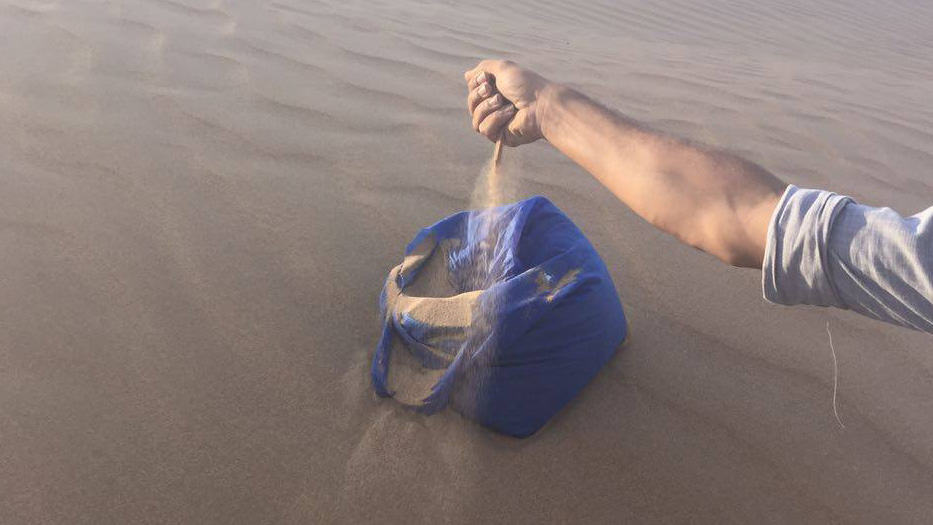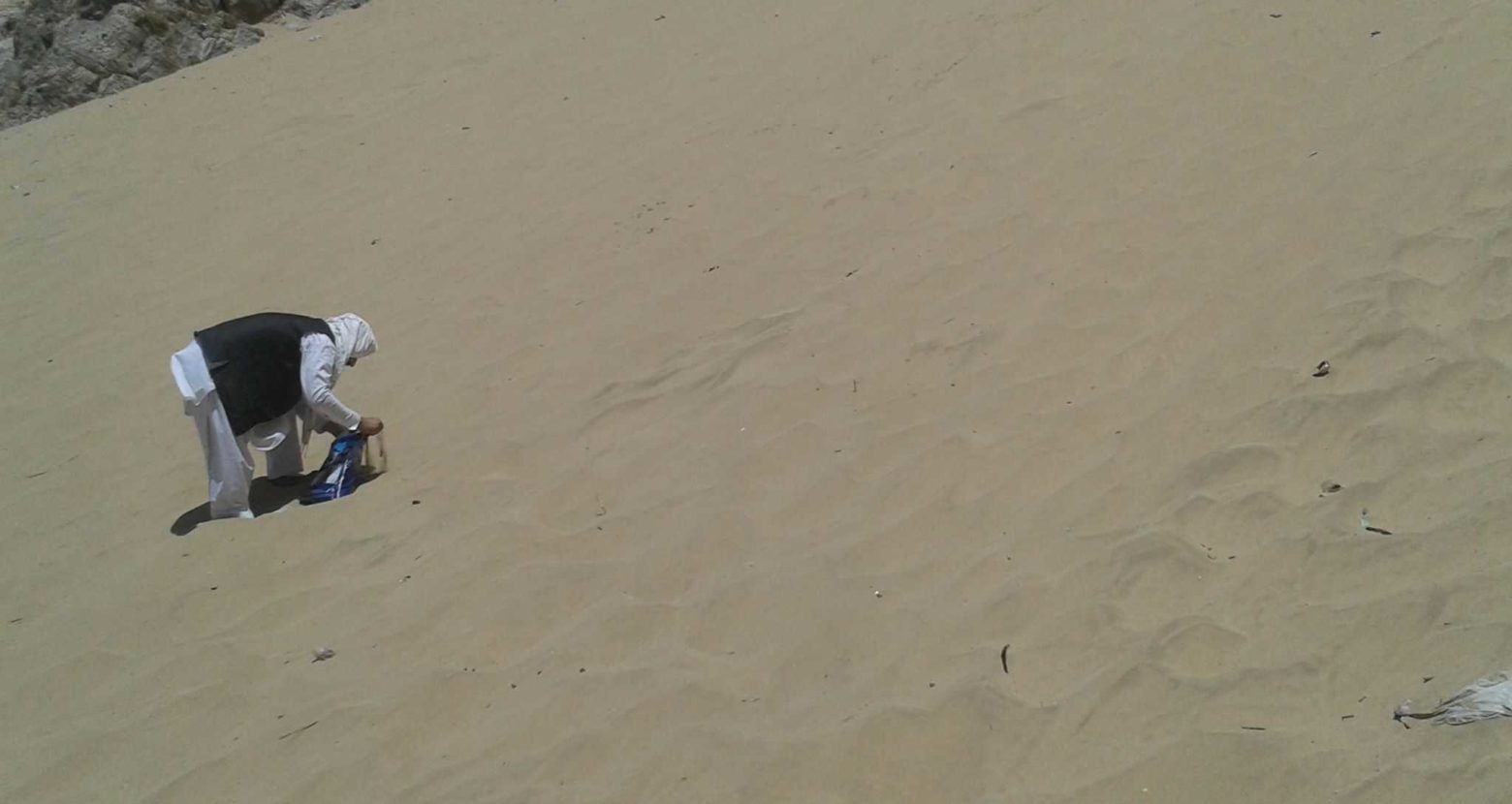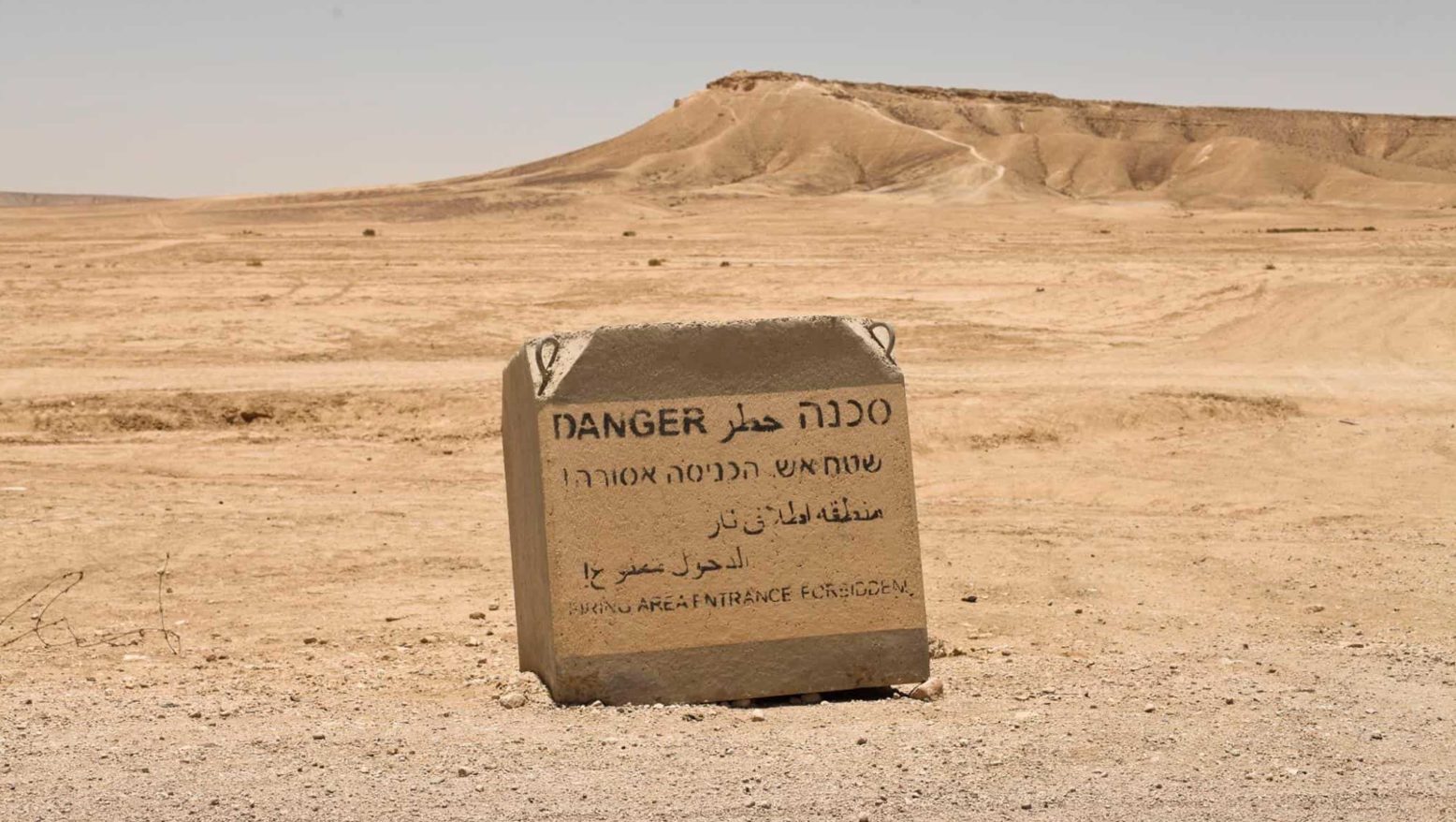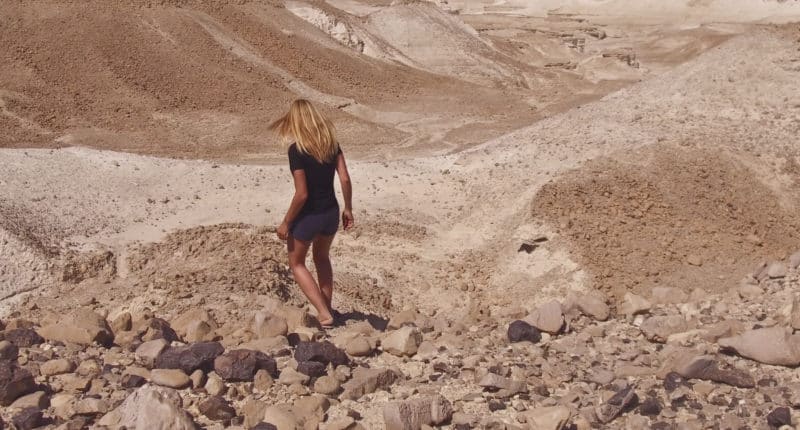Of the samples of singing sand that the Amsterdam-based artist Lotte Geeven is soliciting from desert residents around the globe for her latest work, four batches have made it to Geeven’s doorstep without incident. The rest are languishing—at Dutch customs and police stations, a bus station in Brussels, another office in the Western Sahara—or lost. “Roaring sand is not just something you can buy,” Geeven tells me. For this project, she is prepared to be patient.
Singing sand, a rare variety of sand that emits a thunderous hum as it slides down certain dunes, is a phenomenon exclusive to the planet’s nooks and crannies: spots in Nevada’s Mojave Desert, Chile’s Copiapo, and Mongolia’s Gobi Desert, among others. For The Sand Machine, Geeven, in collaboration with two French acousticians, will assemble twelve machines to amplify the sounds of twelve types of singing sand, allowing these typically distant musics to resound in public for the first time, with an exhibition planned for the Hague. Anyone may send a sample to the address listed on her website by the September deadline; the artist promises to reimburse the costs of shipping.
The Sand Machine from Lotte Geeven on Vimeo.
Resembling a helicopter flying overhead, the sand’s voluminous song maintains an uneasy relationship with its granular source, as though the two had barely met. Each machine, a circular drum a meter-long in diameter, will contain a rotating blade that pushes the sand forward, simulating the environment that permits this peculiar acoustic property. Though the sand has been more difficult to come by than Geeven envisioned, she proceeds unfazed.
Exhibited internationally and inhabiting no single medium, Geeven’s work is as taken with process as with execution. Just as important as the final product are the narratives that happen upon her path, like coltish figure skaters. For In Rarified Air, a study on the origin of myth, she arranged for a crane to place an orange on top of a church in a small town in Belgium, and stood by as local reporters cocked their heads. In several projects, including The Sand Machine, she enlists technical expertise to prod the extremities of our planet: The Sound of the Earth is a recording from the deepest hole on Earth, an approximately 5.5-mile-deep pit on the border of the Czech Republic, which Geeven located after extensive collaboration with several scientists.
Born to two artists, Geeven, thirty-eight, grew up walking among her parents’ sculptures and paintings, which struck her as “puzzles to solve.” The eclectic preoccupations spanning her work often resemble thoughtful pranks, disrupting unassuming spaces. Her residencies, including stints in Xiamen, Tblisi, and Kythera, are experiments with surveillance, sound, and botany, among others, poking at the seams in her surroundings.
The artist was amid preparations for her latest project, Downtime, which she describes as a “citywide still life,” when we met over Skype and email. She had spent weeks knocking on the doors of municipal institutes, seeking permission to turn every traffic light in the city simultaneously red. All that remained was the mayor’s assent. “We wrote her a very challenging email three days ago,” she told me, failing to rein in a smile. “We’re hoping for a reply.”
—Jennifer Gersten for Guernica
Guernica: How did you first become interested in art that engages the natural world?
Lotte Geeven: We live in a systematical world where everything is explained and organized. Beneath this man-made system, there are wild, chaotic forces of nature that choreograph our behavior. While we are inclined to control and explain these forces, I try to see how we can relate to them in a different manner. I find that through art, literature, or poetry we get a deeper, non-intellectual understanding of this unstable world and our place in it.

Guernica: What prompted your interest in the desert, and singing sand in particular?
Lotte Geeven: For me, the desert is like an empty sky. It’s a blank canvas, a projection field for your imagination. It’s almost abstract art. The acoustic sand I’m interested in is rare sand that generates a deep hum when it is put in motion, whether by the wind or by your hand. This acoustic sand occurs only in a few remote locations around the world: a hill in the desert of Mongolia and an area in the middle of the Namib Desert, to name a few. Sliding these layers of sand over one other generates vibrations that emit a deep, low rumbling pitch. This principle can be compared to a bow striking a cello string. In volume, this concert of sand can be as loud as the sound of a helicopter flying over your head.
The singing sand phenomenon has puzzled people for many centuries, and there are various contradicting scientific theories about what exactly makes the sand sing. One thing is for sure: the size, shape, and surface texture of the grains have to be spot on in order for it to generate sound. The sound of this sand is so rare and so strange. So few people have heard this before. Listening, you have almost the same joy that you had when you were a kid, witnessing things around you for the first time. It surrounds you and gets really deep under your skin. When I heard it, I was very moved.
Guernica: Many of your projects involve interacting with earth objects in an unexpected fashion, whether by listening to sand or viewing mercury up close. What sorts of insights become possible as a result of displacing typical sensory relationships with the world?
Lotte Geeven: My works consist of minimal gestures that allow space for reinterpretation. Many of my works—The River, in which I have a river speak through the mouths of hundreds of poets; The Sound of the Earth, in which you listen to the earth roar; 127109 & 129110, in which the sea choreographs an encounter between two objects—explore the interaction between nature and humanity in simple terms. Such works allow the viewer to perceive the forces of the natural world as something unknown that is nevertheless part of us.
“Oman” from Lotte Geeven’s Album. Released: 2017.
Guernica: How did you become invested in obtaining sonic representations of earth materials?
Lotte Geeven: The surfaces of our everyday lives are flooded with images that don’t enter our deeper consciousness. But sound sometimes can wedge its way deeper into the brain and move you. I have always been fascinated by how a natural sound is able to transport us to an atmospheric mental space disconnected from logic or reason. Whenever such a sound has a debatable or mysterious origin, like those sounds produced by the singing sand, the vivid friction between reason and fiction comes into play. The sounds emitted by the deserts are perfect examples of something that can trigger the process of storymaking. It is so strange and impressive that everywhere around the world, many stories arise from sand or a hole in the earth; trying to give meaning to the unknown. How we attribute personal and cultural meaning to these natural happenings speaks to the way we relate to the abstract unknown.
“Liwa” from Lotte Geeven’s Album. Released: 2017.
Imagine that you and I were standing in the middle of the desert right now, and all of a sudden the wind rose, making the whole desertscape around us hum like a gigantic brass band. We would be in total awe. We would tell that story, and it would make its way into local culture because of its extraordinary nature. The sand is thus like a myth: it is polished, eroded, and carried from one generation to the other like whispers.
What I have noticed from collecting singing sand so far is that acoustic landscapes are often personified. In many local stories they become living characters with morality and souls, in the same way that you would bring a dead person to life by talking about them, which I find super fascinating. The Sound of the Earth, a recording of a roaring sound coming from the deepest open hole in the planet, generated a lot of similar reactions. Some people thought it was the sound of hell; others believed they could hear the planet breathe. The Sand Machine is along those lines.
Guernica: How did you decide on the types of sand you wanted to feature in your project?
Lotte Geeven: I started out by making a series of machines with rotating blades to be filled with acoustic sand from all over the world. Two French scientists designed a lab setup that became a blueprint for The Sand Machine.
To fill these machines—or sound instruments, if you wish—I went looking for the sand that creates different tones in different places. Like a detective, I started tracking people down who lived close to the locations using Google Maps. I reached out to them via Twitter, Facebook, email, and phone and asked if they would be willing to send me some sand. To be honest, I felt a bit like a stalker scrolling their Facebook pages and looking for phone numbers. This became an extensive search. Day by day, my artwork became infused with mythical and hilarious stories about the origin of the sounds. At that point the project took a turn, and I decided to also collect the unfolding narratives told to me by the sand collectors. In the end these stories will become part of the work in the form of an additional film. The machines are being named after the people that collected the sand.
“Kazachstan” from Lotte Geeven’s Album. Released: 2017.
Guernica: What sorts of sand samples have you received from volunteers thus far? What do you know about their provenance?
Lotte Geeven: A few batches have arrived so far—they sound amazing, like sound portraits of the unknown. Right now there are a few batches on their way, but some are stuck at customs, and one got lost somewhere between Afghanistan and the Netherlands. Trying to get ahold of sand from remote areas actually seems fairly easy on paper, but proves to be extremely complicated in reality. The Dutch police even called me about one batch because they didn’t trust this big bag of sand. Another batch is stuck in a bus office in Brussels. At the moment there are four more people who will collect some of the sand for this project soon. Fingers crossed.
These difficulties are noteworthy because we live in a time where we could easily order a camera from China or a book from Australia, and within a week or two these objects from the other end of the world have been delivered to our doorsteps. But roaring sand is not just something you can buy—it’s proved to be a rare resource that feels like it needs to be negotiated. Making this sand travel to me requires lots of resourcefulness, determination, patience, luck, and, most of all, the kindness and goodwill of others. The people I found online were at first very surprised and even excited that I had contacted them about sending me some sand. Immediately afterwards, they’d start telling me incredible tales about these sounds.

One of my favorite stories that I’ve collected is from a man named Najibullah, from Afghanistan. He lived close to a singing sand site, and he agreed to my request to go and look for some. About the mountain where the sand was located, the story goes that if you take something from the mountain, it will be returned to the mountain while you are asleep. That’s exactly what happened. He took a huge bag of sand and sent it through customs, and it got lost.
In the end, actually sending the sand has proven to be a step too far for most people, which I can totally understand. About one out of every thirty people has been so incredibly generous and kind to ship the sand to the Netherlands. They include Rizwan, a limousine driver in Oman who likes to smoke his after-work-cigarette in the singing sand dunes, and Melanie, a lady living on the loneliest highway in the world in Nevada, went into the desert and collected sand for my project.

Guernica: Have you collected any sand samples yourself?
Lotte Geeven: I tried collecting acoustic sand too, which resulted in a rather unexpected adventure. I traveled to the Negev desert in Israel after hearing that there was a spot where the sand was supposed to sing. After a long journey, the doors of our bus opened, and I walked out into the desert. I heard a sound, looked to the left, and froze. I was facing a dozen tanks and armed soldiers. The hill of sand was apparently located close to the entrance of a military base, and the guys were completely puzzled by this foreign stranger approaching them with an empty bag and a camera.
At that point a missile exploded one kilometer away from us. This hill was located in the middle of a firing zone close to Gaza, and I was told that the whole mountain was full of unexploded devices and that I wouldn’t be able to get closer. I sat down with the guys and we drank a Coke on the military base. They told me that in the winters, when the wind blows, they can hear the mountain sing. This summer I plan to visit some locations with cameraman Eric Feijten to collect more sand and stories.
Guernica: Your previous project, which entailed recording the sounds of the lowest places on earth, also involved long-term collaborations with physicists, seismologists, and engineers, among other members of the scientific community. What influence has working with science had on how you think about your art?
Lotte Geeven: The way I work is like how scientists work. They set some parameters and make something happen. They drop a ball and then they witness. Similarly, I cannot control the outcome of the artwork—it is choreographed by forces beyond.
When I look for answers to simple questions I pursue in my work—like, what is the sound of the earth?—I always stumble upon scientists at some point. Collaborating with them isn’t always easy. Art and science are two different ball games. But in the end these projects are often as interesting for me as an artist as they are for the scientists. In these collaborations there is space for doubt and the unknown. My work is political in the softest sense of the word—I evoke space for doubt, for new thought and interpretation of the world around us. These qualities are very human and essential. Hard science has no place for this. It looks for answers and I don’t.
“Chile” from Lotte Geeven’s Album. Released: 2017.
Guernica: Oftentimes your work takes the form of a variety of disruption, in which you induce an event within an unexpected landscape. Who do you perceive to be your audience in these “disruptive” projects? Is it you, observing the results of your manipulations? Or the people engaging with the work?
Lotte Geeven: I have a problem with the word “audience.” It places the artwork on a stage somehow, and creates a huge distance between the art and the people engaged with it. I don’t like my art to be high-end stuff that nobody gets; I want to make things that touch people. The art starts when it begins to engage the other, and we become both audience and curator.
Guernica: Have you had difficulty convincing the powers that be to allow such work to proceed?
Lotte Geeven: Downtime is generating the strongest opposition my colleague Yeb Wiersma and I have faced. There have been so many hurdles. During one meeting at city hall, one of the most senior traffic experts told us that our idea was interesting but too negative. He told us about his idea of a winning artistic collaboration—last year, there was apparently a performer who’d dressed up as a traffic light. “That was really beautiful, and we got a lot of positive feedback,” he said. “Your idea is too risky.” We’re slowly overcoming attitudes like that.
In the beginning there is always a lot of struggle. That’s bureaucracy. Slowly things start to sink in, and people realize that something is a beautiful idea. You have to develop a relationship—make the question you’re interested in the question they’re interested in, too.

